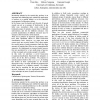Free Online Productivity Tools
i2Speak
i2Symbol
i2OCR
iTex2Img
iWeb2Print
iWeb2Shot
i2Type
iPdf2Split
iPdf2Merge
i2Bopomofo
i2Arabic
i2Style
i2Image
i2PDF
iLatex2Rtf
Sci2ools
SDM
2012
SIAM
2012
SIAM
Monitoring and Mining Insect Sounds in Visual Space
Monitoring animals by the sounds they produce is an important and challenging task, whether the application is outdoors in a natural habitat, or in the controlled environment of a laboratory setting. In the former case the density and diversity of animal sounds can act as a measure of biodiversity. In the latter case, researchers often create control and treatment groups of animals, expose them to different interventions, and test for different outcomes. One possible manifestation of different outcomes may be changes in the bioacoustics of the animals. With such a plethora of important applications, there have been significant efforts to build bioacoustic classification tools. However, we argue that most current tools are severely limited. They often require the careful tuning of many parameters (and thus huge amounts of training data), they are too computationally expensive for deployment in resource-limited sensors, they are specialized for a very small group of species, or they are...
| Added | 29 Sep 2012 |
| Updated | 29 Sep 2012 |
| Type | Journal |
| Year | 2012 |
| Where | SDM |
| Authors | Yuan Hao, Bilson J. L. Campana, Eamonn J. Keogh |
Comments (0)

